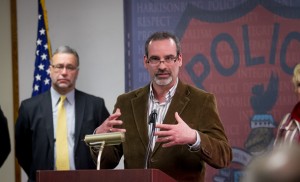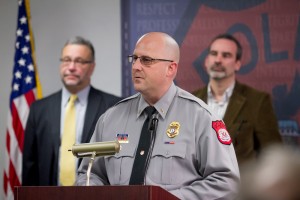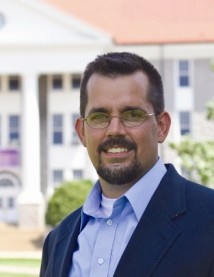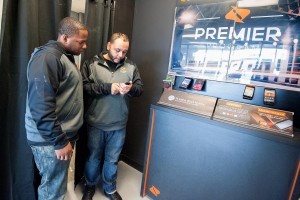About a year ago, Harrisonburg business owner Cam Murphy noticed a few cellphones missing from the kiosk he owned in the Valley Mall.
The inventory just didn’t add up.
So, he called the Harrisonburg Police Department. An investigation led to one of his employees — his younger brother. The 18-year-old was stealing phones and submitting them to a machine in the mall that pays cash for electronic devices.
Murphy, who had a run-in with the law when he was 18, found himself in a tough situation. Murphy had to decide whether to press charges against his little brother, knowing what that might mean for the future.
“I’m branded with a felony for the rest of my life,” said Murphy, a football player who also ran track, and spent a year in jail after robbing a man during his senior year at Harrisonburg High School. “If I let that happen to my brother, he would have been a felon. I didn’t want him to go through what I did.”
A different approach

So Murphy turned to restorative justice — a program implemented by the Harrisonburg Police Department in March 2015 as an alternative to the traditional criminal justice system. Instead of merely looking at punishing an offender, restorative justice focuses on the needs of the victims, offenders and the community at large to resolve a crime.
With the guidance of a mediator, offender and victim discuss the effects of the harm done by the crime and come up with resolution. Carl Stauffer, associate professor of development and justice studies for the Center for Justice and Peacebuilding at Eastern Mennonite University, said some restorative practices can be traced back to ancient practices but contemporary practices started to pop up in the 1970s.
The professor points to a 1974 case in Elmira, Ontario, where a probation officer came across two young adults who vandalized 22 homes. The officer was fed up with the system. Typically, the offenders would have been issued a fine, moved on and likely reoffended. With the help of a Mennonite prison worker, a different kind of punishment was proposed.
The probation officer “had a very simple idea,” Stauffer said. “Take these guys and knock on each door of these 22 houses and make them face the persons they harmed, and explain … that they’re sorry and that they were willing to make restitution. “It was so successful that it took hold and began to grow exponentially.”
In the late 1970s, Howard Zehr — known as the grandfather of restorative justice in the United States — began experimenting with restorative justice in Indiana. In 1996, Zehr began teaching at EMU.
Combined with the Mennonite belief system that centers on peace and nonviolence, restorative justice resonated with many in the Harrisonburg area. Stauffer would later work beside Zehr teaching restorative justice practices. He said a shift toward restorative justice should lower recidivism rates — the percentage of people who reoffend after leaving jail — and reduce the cost of prosecuting offenders and jailing inmates.
“There’s a good portion of the system that isn’t working anymore,” said Stauffer. “It’s in fact not yielding the intended outcomes that we want from it. … The pillars of our current system say this is … to deter people from doing crime, so we show how punitive we can be.”
Catching on
The Fairfield Center in Harrisonburg launched its restorative justice program in 1999. Sue Praill, who graduated from EMU in 2010 with a master’s in conflict transformation, was frustrated with the lack of cases that were being referred to the center. Praill, Fairfield’s director of restorative justice, approached administrators about implementing a program about two years ago.
Lt. Kurt Boshart, who know oversees HPD’s program, was receptive.

“I heard about restorative justice, but didn’t know a lot about it,” Boshart said. He was one of the first to go through training at EMU, an experience he says opened his eyes to an entire new way of thinking.
“It gives the victim a voice,” said Boshart, adding that the approach will be used on selective cases only. “Restorative justice isn’t the answer to every case, but it’s a tool. If the victim doesn’t want to do it, we don’t go there.”
HPD set up a steering committee and review team to establish guidelines and review cases to be handled through restorative justice. To go through the process, the responding officer to a crime refers the case for the committee to review. Cases can range widely from shoplifting and larceny or assaults.
For the case to be considered, it has to might three pieces of criteria: The victim has to agree to participate, the offender must agree and the offender has to admit to the crime. Boshart stressed offenders who are recommended for the program are not getting a free pass. Many have to be pay restitution, perform community service and, in some cases, face up to other problems that are going on their lives.
“A lot of them say it would have been easier to go to court and pay the fine,” Boshart said.
Praill is excited to see cases being resolved through restorative justice. “It was like the missing piece of the jigsaw puzzle,” she said. “When people come face-to-face and have a conversation, amazing things can happen. Sometimes all victims want to hear is ‘I’m sorry.'”
With restorative justice, she said, the hope is people don’t reoffend. “We’re hoping, over time, we can break that cycle,” Praill said.
Leading the way

Restorative justice is already being used in Harrisonburg City Schools and at James Madison University. Josh Bacon, director of the Office of Student Accountability and Restorative Practices at JMU, implemented the approach about five years ago after taking Zehr’s course at EMU. “I was blown away by what it is and what it does,” Bacon said. “So I started taking more courses.”
Not everyone thought it would work at JMU. “I remember most people I told in the beginning said no way are college students going to be able to talk to each other like that,” he said. “They text each other. They don’t even like being in the same room as each other. But we set up the rules, we set up the guidelines and it has blown me away about how they treat each other.”
This year, Bacon used restorative justice practices in cases against students who were caught stealing bricks from the Quad, an annual tradition that’s led to about 1,000 having been stolen this year.
Regardless of the type of case, Bacon said, restorative justice teaches life lessons.
“They will learn how to deal with conflict for the rest of their lives in a different way,” he said. “They can sit down and talk to people withrespect.”
‘There’s always a what if’

Bacon acted as mediator for Murphy and his brother’s case. During the meeting, the younger brother expressed a lot of pain, Bacon said. His mother died and his stepfather left when he graduated high school. He was struggling to survive financially and emotionally.
“All these deeper issues came out that wouldn’t have during the criminal justice system,” Bacon said. “If you hear his story, it’s just heartbreaking.”
Murphy hopes restorative justice practices continue to expand in law enforcement. “So many young kids don’t have options,” he said. “It’s straight to jail.”
He was pleased to give his brother an option.
“Restorative justice gave him a second chance,” Murphy said. “I could have been ruthless and said, ‘You’re going to learn your lesson.'”
As are result of the alternative approach, the younger brother had to repay or work off the debt, meet with a mentor and develop a life plan, which included attending Blue Ridge Community College.
Murphy struggled as young adult after his felony conviction. He found it hard to find jobs so he started his own business from the ground up. He recently closed the kiosk in the Valley Mall and opened a Boost Mobile store in Waynesboro last month.
Although he’s found a measure of success, he questions what his life would be like if restorative justice had been an option for him. “I’m happy where I am, but there’s always a what-if,” Murphy said.
Published with permission from the Daily News-Record, March 4, 2016.
